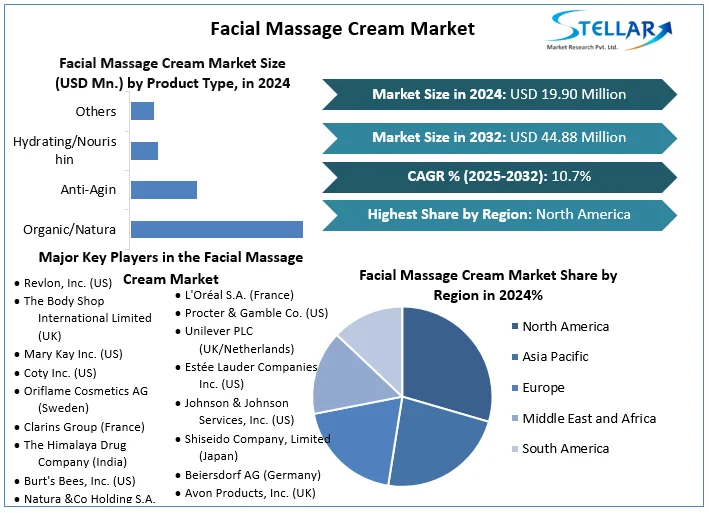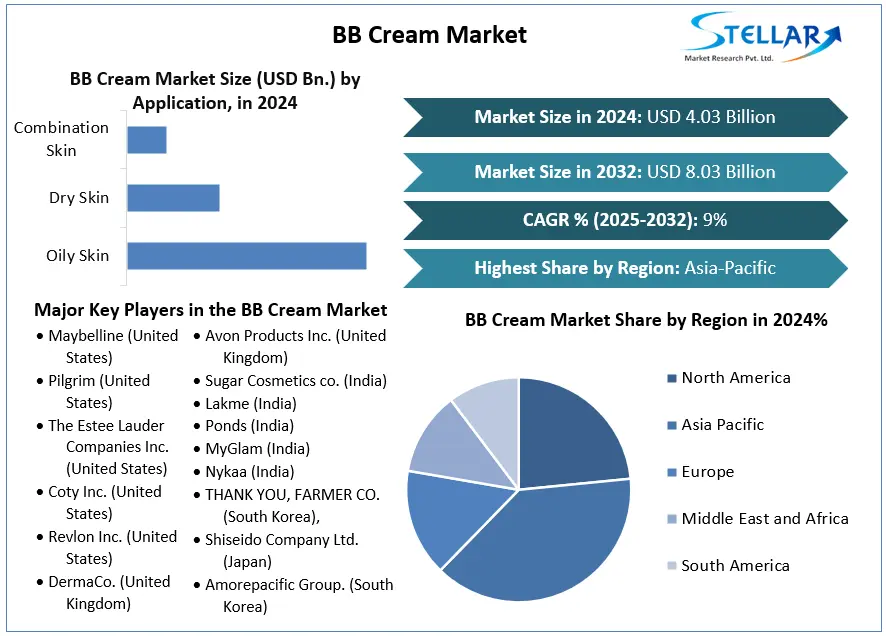Facial Massage Cream Market Size To Grow At A CAGR Of 10.7% In The Forecast Period Of 2025-2032
Global Facial Massage Cream Market Set for Robust Growth Through 2032
Request Free Sample Report:https://www.stellarmr.com/report/req_sample/Facial-Massage-Cream-Market/1902
Market Estimation & Definition
The global facial massage cream market is witnessing significant growth, fueled by rising consumer focus on skincare, anti-aging, and wellness trends. Facial massage creams are specialized cosmetic products formulated to improve skin elasticity, hydration, and overall facial appearance while facilitating massage. These creams often contain active ingredients such as vitamins, herbal extracts, essential oils, and antioxidants. The market caters to both professional spa services and at-home skincare routines, with rising awareness of facial massage benefits driving demand globally.
Market Growth Drivers & Opportunities
Several factors are propelling growth in the facial massage cream market:
Rising Skincare Awareness: Consumers are increasingly adopting comprehensive skincare routines emphasizing anti-aging and rejuvenation.
Growth of the Beauty and Wellness Industry: Spas, salons, and professional massage services fuel demand for premium facial creams.
Natural and Organic Product Trends: Preference for herbal and organic formulations boosts consumer trust and adoption.
E-commerce Expansion: Online retail channels enable convenient access to a wide range of products, including international and niche brands.
Rising Disposable Income: Growing purchasing power allows consumers to invest in premium and professional-grade facial massage creams.
Emerging Trends Shaping the Future
The facial massage cream market is evolving with several key trends:
Organic and Plant-Based Ingredients: Increasing popularity of herbal extracts, essential oils, and chemical-free formulations.
Personalized Skincare Solutions: Products designed for specific skin types, concerns, and demographics.
Integration with Beauty Tools: Facial massage creams used alongside rollers, gua sha stones, and electronic massagers for enhanced results.
Premium and Luxury Offerings: High-end formulations targeting affluent consumers seeking professional spa-like experiences at home.
Segmentation Analysis
The facial massage cream market is segmented based on product type, distribution channel, and end-user:
By Product Type:
Anti-Aging Creams: Formulated to reduce wrinkles and fine lines.
Moisturizing Creams: Focused on hydrating and nourishing the skin.
Herbal/Natural Creams: Contain plant-based extracts for gentle and safe skincare.
Luxury/Professional Creams: Premium formulations used in spas and salons.
By Distribution Channel:
Online: E-commerce platforms offering convenience, variety, and home delivery.
Offline: Retail stores, specialty cosmetic shops, and professional beauty salons providing direct purchase.
By End-User:
Individual Consumers: Home users seeking skincare and anti-aging benefits.
Professional Services: Spas, salons, and wellness centers incorporating massage creams in treatments.
Country-Level Analysis
United States: The U.S. market is growing due to increasing skincare awareness, higher disposable income, and strong adoption of luxury and organic products.
Germany: Germany demonstrates steady growth, driven by the demand for natural and premium skincare products and the presence of a well-established beauty and wellness industry.
Competitive Landscape
The facial massage cream market is competitive, with key players focusing on innovation, natural formulations, and brand differentiation:
L’Oréal S.A.: Offers premium and herbal facial massage creams across global markets.
Estée Lauder Companies: Focuses on anti-aging and luxury formulations.
Shiseido Company, Limited: Provides professional and high-performance massage creams.
The Body Shop: Known for natural and ethically sourced skincare products.
Regional and Local Brands: Emphasize affordability, herbal ingredients, and niche market targeting.
Press Release Conclusion
The global facial massage cream market is poised for robust growth, driven by increasing skincare awareness, wellness trends, and the demand for organic and premium formulations. Emerging trends such as personalized solutions, integration with beauty tools, and eco-friendly ingredients are shaping the market’s future. With countries like the U.S. and Germany leading adoption, manufacturers, retailers, and investors should focus on innovation, quality, and sustainability to capitalize on opportunities in this evolving and dynamic market.
About us
Phase 3,Navale IT Zone, S.No. 51/2A/2,
Office No. 202, 2nd floor,
Near, Navale Brg,Narhe,
Pune, Maharashtra 411041
sales@stellarmr.com
Global Facial Massage Cream Market Set for Robust Growth Through 2032
Request Free Sample Report:https://www.stellarmr.com/report/req_sample/Facial-Massage-Cream-Market/1902
Market Estimation & Definition
The global facial massage cream market is witnessing significant growth, fueled by rising consumer focus on skincare, anti-aging, and wellness trends. Facial massage creams are specialized cosmetic products formulated to improve skin elasticity, hydration, and overall facial appearance while facilitating massage. These creams often contain active ingredients such as vitamins, herbal extracts, essential oils, and antioxidants. The market caters to both professional spa services and at-home skincare routines, with rising awareness of facial massage benefits driving demand globally.
Market Growth Drivers & Opportunities
Several factors are propelling growth in the facial massage cream market:
Rising Skincare Awareness: Consumers are increasingly adopting comprehensive skincare routines emphasizing anti-aging and rejuvenation.
Growth of the Beauty and Wellness Industry: Spas, salons, and professional massage services fuel demand for premium facial creams.
Natural and Organic Product Trends: Preference for herbal and organic formulations boosts consumer trust and adoption.
E-commerce Expansion: Online retail channels enable convenient access to a wide range of products, including international and niche brands.
Rising Disposable Income: Growing purchasing power allows consumers to invest in premium and professional-grade facial massage creams.
Emerging Trends Shaping the Future
The facial massage cream market is evolving with several key trends:
Organic and Plant-Based Ingredients: Increasing popularity of herbal extracts, essential oils, and chemical-free formulations.
Personalized Skincare Solutions: Products designed for specific skin types, concerns, and demographics.
Integration with Beauty Tools: Facial massage creams used alongside rollers, gua sha stones, and electronic massagers for enhanced results.
Premium and Luxury Offerings: High-end formulations targeting affluent consumers seeking professional spa-like experiences at home.
Segmentation Analysis
The facial massage cream market is segmented based on product type, distribution channel, and end-user:
By Product Type:
Anti-Aging Creams: Formulated to reduce wrinkles and fine lines.
Moisturizing Creams: Focused on hydrating and nourishing the skin.
Herbal/Natural Creams: Contain plant-based extracts for gentle and safe skincare.
Luxury/Professional Creams: Premium formulations used in spas and salons.
By Distribution Channel:
Online: E-commerce platforms offering convenience, variety, and home delivery.
Offline: Retail stores, specialty cosmetic shops, and professional beauty salons providing direct purchase.
By End-User:
Individual Consumers: Home users seeking skincare and anti-aging benefits.
Professional Services: Spas, salons, and wellness centers incorporating massage creams in treatments.
Country-Level Analysis
United States: The U.S. market is growing due to increasing skincare awareness, higher disposable income, and strong adoption of luxury and organic products.
Germany: Germany demonstrates steady growth, driven by the demand for natural and premium skincare products and the presence of a well-established beauty and wellness industry.
Competitive Landscape
The facial massage cream market is competitive, with key players focusing on innovation, natural formulations, and brand differentiation:
L’Oréal S.A.: Offers premium and herbal facial massage creams across global markets.
Estée Lauder Companies: Focuses on anti-aging and luxury formulations.
Shiseido Company, Limited: Provides professional and high-performance massage creams.
The Body Shop: Known for natural and ethically sourced skincare products.
Regional and Local Brands: Emphasize affordability, herbal ingredients, and niche market targeting.
Press Release Conclusion
The global facial massage cream market is poised for robust growth, driven by increasing skincare awareness, wellness trends, and the demand for organic and premium formulations. Emerging trends such as personalized solutions, integration with beauty tools, and eco-friendly ingredients are shaping the market’s future. With countries like the U.S. and Germany leading adoption, manufacturers, retailers, and investors should focus on innovation, quality, and sustainability to capitalize on opportunities in this evolving and dynamic market.
About us
Phase 3,Navale IT Zone, S.No. 51/2A/2,
Office No. 202, 2nd floor,
Near, Navale Brg,Narhe,
Pune, Maharashtra 411041
sales@stellarmr.com
Facial Massage Cream Market Size To Grow At A CAGR Of 10.7% In The Forecast Period Of 2025-2032
Global Facial Massage Cream Market Set for Robust Growth Through 2032
Request Free Sample Report:https://www.stellarmr.com/report/req_sample/Facial-Massage-Cream-Market/1902
Market Estimation & Definition
The global facial massage cream market is witnessing significant growth, fueled by rising consumer focus on skincare, anti-aging, and wellness trends. Facial massage creams are specialized cosmetic products formulated to improve skin elasticity, hydration, and overall facial appearance while facilitating massage. These creams often contain active ingredients such as vitamins, herbal extracts, essential oils, and antioxidants. The market caters to both professional spa services and at-home skincare routines, with rising awareness of facial massage benefits driving demand globally.
Market Growth Drivers & Opportunities
Several factors are propelling growth in the facial massage cream market:
Rising Skincare Awareness: Consumers are increasingly adopting comprehensive skincare routines emphasizing anti-aging and rejuvenation.
Growth of the Beauty and Wellness Industry: Spas, salons, and professional massage services fuel demand for premium facial creams.
Natural and Organic Product Trends: Preference for herbal and organic formulations boosts consumer trust and adoption.
E-commerce Expansion: Online retail channels enable convenient access to a wide range of products, including international and niche brands.
Rising Disposable Income: Growing purchasing power allows consumers to invest in premium and professional-grade facial massage creams.
Emerging Trends Shaping the Future
The facial massage cream market is evolving with several key trends:
Organic and Plant-Based Ingredients: Increasing popularity of herbal extracts, essential oils, and chemical-free formulations.
Personalized Skincare Solutions: Products designed for specific skin types, concerns, and demographics.
Integration with Beauty Tools: Facial massage creams used alongside rollers, gua sha stones, and electronic massagers for enhanced results.
Premium and Luxury Offerings: High-end formulations targeting affluent consumers seeking professional spa-like experiences at home.
Segmentation Analysis
The facial massage cream market is segmented based on product type, distribution channel, and end-user:
By Product Type:
Anti-Aging Creams: Formulated to reduce wrinkles and fine lines.
Moisturizing Creams: Focused on hydrating and nourishing the skin.
Herbal/Natural Creams: Contain plant-based extracts for gentle and safe skincare.
Luxury/Professional Creams: Premium formulations used in spas and salons.
By Distribution Channel:
Online: E-commerce platforms offering convenience, variety, and home delivery.
Offline: Retail stores, specialty cosmetic shops, and professional beauty salons providing direct purchase.
By End-User:
Individual Consumers: Home users seeking skincare and anti-aging benefits.
Professional Services: Spas, salons, and wellness centers incorporating massage creams in treatments.
Country-Level Analysis
United States: The U.S. market is growing due to increasing skincare awareness, higher disposable income, and strong adoption of luxury and organic products.
Germany: Germany demonstrates steady growth, driven by the demand for natural and premium skincare products and the presence of a well-established beauty and wellness industry.
Competitive Landscape
The facial massage cream market is competitive, with key players focusing on innovation, natural formulations, and brand differentiation:
L’Oréal S.A.: Offers premium and herbal facial massage creams across global markets.
Estée Lauder Companies: Focuses on anti-aging and luxury formulations.
Shiseido Company, Limited: Provides professional and high-performance massage creams.
The Body Shop: Known for natural and ethically sourced skincare products.
Regional and Local Brands: Emphasize affordability, herbal ingredients, and niche market targeting.
Press Release Conclusion
The global facial massage cream market is poised for robust growth, driven by increasing skincare awareness, wellness trends, and the demand for organic and premium formulations. Emerging trends such as personalized solutions, integration with beauty tools, and eco-friendly ingredients are shaping the market’s future. With countries like the U.S. and Germany leading adoption, manufacturers, retailers, and investors should focus on innovation, quality, and sustainability to capitalize on opportunities in this evolving and dynamic market.
About us
Phase 3,Navale IT Zone, S.No. 51/2A/2,
Office No. 202, 2nd floor,
Near, Navale Brg,Narhe,
Pune, Maharashtra 411041
sales@stellarmr.com
0 Comments
0 Shares
13 Views
0 Reviews





